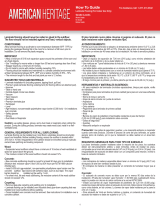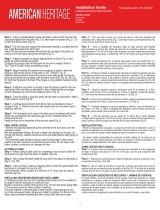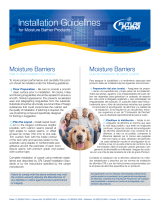
Laminate ooring should never be nailed or glued to the suboor.
The oor should not be installed against any xed, vertical objects.
CONDITIONING:
Allow laminate ooring to acclimate to room temperature (between 65ºF -75ºF) by placing
the packaged ooring at in the room for a minimum of 48 hours prior to installation. Do
not remove the plastic wrapping.
IMPORTANT
• Allow a minimum of 5/16 inch expansion space around the perimeter of the room and
any xed objects.
• Use T-moldings for rooms wider or longer than 30 feet and openings less than 6 feet.
• Stagger boards by a minimum of 8 inches.
• Do not install in rooms with relative humidity exceeding 70%.
• Flooring should be installed and maintained in a climate controlled environment with
ambient temperature between 60ºF - 80ºF and a relative humidity of 35% - 70%.
• The minimum length for the rst and last plank per row is 12 inches.
SUGGESTED TOOLS AND MATERIALS:
• Laminate installation kit (including spacers, tapping block, pull bar)
• Premium grade laminate ooring underlayment (for ooring without an attached pad).
• Hammer
• Table or hand saw
• Carbide-tipped circular saw blades
• Vacuum
• Tape measure
• Duct tape
• Premium laminate glue
• Sandpaper
• Level
• Age-resistant, non-permeable polyethylene vapor barrier (0.008 inch) - for installations
over concrete
• Safety glasses
• Gloves
• Dust Mask or Respirator
Caution: use safety glasses, gloves, and a dust mask or respirator when cutting this
product. During the cutting process, laminate may create wood dust; install in a well-
ventilated area.
GENERAL REQUIREMENTS FOR ALL SUBFLOORING:
Laminate ooring can be installed over most oors; substrates should be structurally
sound and immobile. Before installing ooring, ensure the suboor is leveled within 3/16
inch in 10 feet. Irregularities in the suboor should be smoothed using a hydraulic cement
base patching and leveling compound.
Wood:
• Suspended wood suboors should have a minimum of 18 inches of well-ventilated air
space air space above the ground.
• The moisture content of the wood suboor should not exceed 12%.
Concrete:
• New concrete subooring should be cured for at least 90 days prior to installation.
(Moisture test: moisture vapor<3 lbs/1,000 sq ft/24 hours per ASTM 1869 calcium chloride
test).
• Install 0.008 inch age-resistant, non-permeable polyethylene vapor barrier over the
concrete suboor. Tape seams with adhesive tape, such as duct tape. The vapor barrier
should be installed up the wall by 1 inch.
• For sheet vinyl, tile and wood subooring, the moisture content of the wood suboor
should not exceed 12%.
Carpeting:
• Remove deep-pile carpeting and padding prior to installation.
• Laminate ooring can be installed over industrial direct glue-down carpeting that was
installed over wood suboors without padding.
• Carpet installed over concrete must be removed. See instructions for installation over a
concrete suboor.
El piso laminado nunca debe clavarse ni pegarse al subsuelo. El piso no
debe instalarse sobre objetos verticales jos.
ACONDICIONAMIENTO:
Permita que el piso laminado se adapte a la temperatura ambiente (entre 18,3 ºC y 23,8
ºC) y la humedad relativa del 30% al 70%. Para ello, deje el piso sin desempacar en la
habitación un mínimo de 48 horas antes de la instalación. No retire la envoltura plástica.
IMPORTANTE
• Deje un espacio de expansión de 7,94 mm (5/16 pulg.) como mínimo alrededor del
perímetro de la h-blhclún y de cu-lquler objeto lun.
• Use molduras en T para habitaciones de más de 9,14 m (30 pies) y aberturas menores
a 1,82 m (6 pies).
• Las tablas deben estar escalonadas en un mínimo de 30,48 cm (12 pulg.).
• No instale el piso en habitaciones con un nivel de humedad relativa que supere el 70 %.
• Los pisos deben instalarse y mantenerse en un entorno de clima controlado, en el
que la temperatura ambiente oscile entre 15,5 ºC y 26,6 ºC (60 ºF y 80 ºF) y tenga una
humedadrelativa de entre 35 % y 10 %.
• El largo mínimo para la primera y la última plancha por illa es de 30,48 cm (12 pulg.).
HERRAMIENTAS Y MATERIALES SUGERIDOS:
• Kit para instalación de laminados (incluidos espaciadores, bloque para ajuste, varilla
de maniobra)
• Contrapiso para pisos laminados de primera calidad (para pisos sin una base adherida)
• Martillo
• Sierra de mesa o serrucho
• Hojas de sierra circular con punta de carburo
• Aspiradora
• Cinta métrica
• Cinta aislante
• Pegamento para laminado de primera calidad
• Papel de lija
• Nivel
• Barrera de vapor de polietileno impermeable resistente al paso del tiempo
(0,20 mm [0.008 pulg.]) para instalación sobre concreto
• Gafas de seguridad
• Guantes
• Mascarilla antipolvo o respirador
Precaución: Use gafas de seguridad, guantes y una mascarilla antipolvo o respirador
cuando corte este producto. Durante el proceso de corte del piso laminado, se puede
generar polvo de madera, por lo que la instalación se debe realizar en un área bien
ventilada.
REQUISITOS GENERALES PARA TODO TIPO DE SUBSUELO:
Los pisos laminados pueden instalarse sobre la mayoría de los pisos; los sustratos
deben ser estructuralmente sólidos y estar inmóviles. Antes de instalar los pisos,
compruebe que el nivel del subsuelo sea de 0,47 cm (3/16 pulg.) en 3,04 m (10 pies). Las
irregularidades del subsuelo se deben alisar con un compuesto para resanar y nivelar a
base de cemento hidráulico.
Madera:
• Los contrapisos de madera suspendida deben tener un mínimo de 18 pulg (45,72 cm)
de espacio de aire bien ventilado desde el piso.
• El contrapiso de madera no debe presentar un contenido de humedad mayor que al
12 %.
Concreto:
• EI subsuelo de concreto nuevo se debe curar por lo menos 90 días antes de la
instalación. (Prueba de humedad: vapor húmedo < 3 Ib/1000 pies cuadrados/24 horas,
según la prueba con cloruro de calcio conforme a la norma ASTM 1869).
• Instale una barrera de vapor impermeable de polietileno de 0,20 mm (0.008 pulg.)
resistente al paso del tiempo sobre el subsuelo de concreto. Debe colocar cinta adhesiva,
como cinta aislante, en las uniones. La barrera de vapor debe instalarse por la pared a
2,54 cm (1 pulg).
• Para subsuelo de Vinilo en lámina, baldosa y madera, el contenido de humedad del
subsuelo de madera no debe ser superior a un 12 %.
For Assistance, Call: 1-877-213-8532
How To Guide
Laminate Flooring (For Indoor Use Only)
Grade Levels
Above Grade
On Grade
Below Grade
1

Radiant Heating Systems:
• Laminate ooring can be installed on under-oor radiant heating systems if the heating
element is installed into wood or concrete suboors.
• Lower heating system to 60ºF for 1 week before installation.
• After installation, slowly increase the temperature in increments of 10ºF per hour.
• Surface temperature must not exceed 85ºF.
• Follow installation instructions for wood or concrete as outlined above.
ROOM PREPARATION:
1. Remove all existing moldings.
2. If room has electric baseboard heaters, leave a minimum of 1/2 inch between the
surface of the ooring and the bottom of the heaters, allowing heat to circulate.
3. Check door clearances and make necessary adjustments before laying the ooring.
Door moldings (jambs) should be undercut to accommodate the thickness of the ooring
as well as the underlayment (whether pre-attached or installed separately).
4. Install premium grade laminate ooring underlayment per the manufacturers
instructions.
5. Inspect each plank for defects prior to installation. Do not install defective planks;
installation of defective planks implies acceptance of material.
6. Determine which direction to lay the planks. If installing in narrow hallways or small
rooms, the area will appear larger if ooring is laid parallel to the longest wall.
IMPORTANT HEALTH NOTICE FOR MINNESOTA RESIDENTS ONLY:
These building materials emit formaldehyde. Eye, nose, and throat irritation, headache,
nausea and a variety of asthma like symptoms, including shortness of breath,
have been reported as a result of formaldehyde exposure. Elderly persons and
young children, as well as anyone with a history of asthma, allergies, or lung problems,
may be at greater risk. Research is continuing on the possible long-term effects
of exposure to formaldehyde. Reduced ventilation allows formaldehyde
and other contaminants to accumulate in the indoor air. High indoor temperatures and
humidityraise formaldehyde levels. When a home is to be located in areas subject to
extreme summer temperatures, an air-conditioning system can be used to control indoor
temperature levels. Other means of controlled mechanical ventilation can be used
to reduce levels of formaldehyde and other indoor air contaminates. If you have any
questions regarding the health effects of formaldehyde, consult your doctor or call local
health department.
Alfombras:
• Retire las alfombras gruesas y el acolchado antes de la instalación de los pisos
laminados.
• Los pisos laminados pueden instalarse sobre alfombras industriales de pegado directo
instaladas sobre subsuelos de madera sin acolchado.
• Debe retirar la alfombra instalada sobre concreto. Consulte las instrucciones de
instalación sobre un subsuelo de concreto.
Sistemas de calefacción radiante:
• Los pisos laminados pueden instalarse sobre los sistemas de calefacción radiante si el
elemento calentador se instala sobre subsuelos de madera o concreto.
• Baje el ajuste del sistema de calefacción a 15,5 ºc (60 ºF) 1 semana antes de la
instalación.
• Después de la instalación, puede aumentar lentamente la temperatura en Incrementos
de 6 ºc (10 ºF) por hora.
• La temperatura de la supercie no debe superar los 29,4 ºc (85 ºF).
• Siga las instrucciones de instalación sobre madera o concreto descritas anteriormente.
PREPARACION DE LA HABITACION:
1. Retire todas las molduras.
2. Si en la habitación hay calentadores eléctricos de zócalo, deje un minimo de 1,27
cm.(1/2 pulg.) entre la supercie de los pisos y la base del calentador para que circule
el calor.
3. Revise los espacios de las puertas y haga los ajustes necesarios antes de instalar los
pisos. Las molduras de las puertas (jambas) deben cortarse para adaptarlas al grosor del
piso y del contrapiso (previamente instalado o instalado por separado).
4. Instale el contrapiso según las instrucciones del fabricante (para pisos sin una base
adherida).
5. Inspeccione cada plancha en busca de defectos antes de la instalación. No instale
planchas defectuosas; si lo hace, signica que acepta
las condiciones del material.
6. Determine el sentido en que instalará las planchas. Si la instalación se realiza en
pasillos estrechos o en habitaciones pequeñas, el área parecerá más grande si el piso
se instala paralelo a la pared más larga.
For Assistance, Call: 1-877-213-8532
How To Guide
Laminate Flooring (For Indoor Use Only)
Grade Levels
Above Grade
On Grade
Below Grade
2
-
 1
1
-
 2
2
Allen + Roth 370831-80203 Manual de usuario
- Tipo
- Manual de usuario
- Este manual también es adecuado para
en otros idiomas
Artículos relacionados
Otros documentos
-
 Style Selections 371231-31569 Manual de usuario
Style Selections 371231-31569 Manual de usuario
-
Innovations FL50008 Guía de instalación
-
 Bruce EHWR54L50W Guía de instalación
Bruce EHWR54L50W Guía de instalación
-
Bruce SKFR39M50S Guía de instalación
-
 Style Selections 371231-31569 Guía de instalación
Style Selections 371231-31569 Guía de instalación
-
Eco Cork Foam 2200000135 Guía de instalación
-
LifeProof 100502800-04 Guía de instalación
-
 Future Foam 150553408-33 Instrucciones de operación
Future Foam 150553408-33 Instrucciones de operación





